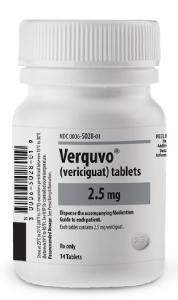Verquvo and Alcohol/Food Interactions
There is 1 alcohol/food/lifestyle interaction with Verquvo (vericiguat).
Vericiguat Food/Lifestyle
Moderate Food Interaction
ADJUST DOSING INTERVAL: Administration of vericiguat with food reduces its pharmacokinetic variability and increases its exposure. Vericiguat is less soluble at neutral pH than at acidic pH. Administration of vericiguat with a high-fat, high-calorie meal or low-fat, high-carbohydrate meal increased time to reach peak plasma concentration (Tmax) from about 1 hour (fasted) to about 4 hours (fed) and increased vericiguat systemic exposure (AUC) by 19% and peak plasma concentration (Cmax) by 9% for the 5 mg tablet and by 44% (AUC) and 41% (Cmax) for the 10 mg tablet as compared with the fasted state. Concurrent treatment with drugs that increase gastric pH, such as proton pump inhibitors or antacids, decrease vericiguat AUC by about 30%. Co-treatment with drugs that increase gastric pH did not affect vericiguat exposure in patients with heart failure when vericiguat was taken as directed with food.
MANAGEMENT: Administer vericiguat with food to ensure maximal exposure and decrease pharmacokinetic variability.
References (2)
- Cerner Multum, Inc. "UK Summary of Product Characteristics."
- (2021) "Product Information. Verquvo (vericiguat)." Merck & Co., Inc
Switch to consumer interaction data
Verquvo drug interactions
There are 124 drug interactions with Verquvo (vericiguat).
Verquvo disease interactions
There are 2 disease interactions with Verquvo (vericiguat) which include:
More about Verquvo (vericiguat)
- Verquvo consumer information
- Check interactions
- Compare alternatives
- Pricing & coupons
- Reviews (3)
- Drug images
- Side effects
- Dosage information
- During pregnancy
- FDA approval history
- Drug class: vasodilators
- En español
Related treatment guides
Drug Interaction Classification
| Highly clinically significant. Avoid combinations; the risk of the interaction outweighs the benefit. | |
| Moderately clinically significant. Usually avoid combinations; use it only under special circumstances. | |
| Minimally clinically significant. Minimize risk; assess risk and consider an alternative drug, take steps to circumvent the interaction risk and/or institute a monitoring plan. | |
| No interaction information available. |
See also:
Further information
Always consult your healthcare provider to ensure the information displayed on this page applies to your personal circumstances.


